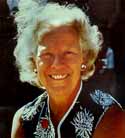
Harriet Naylor, always known familiarly as "Hat," was one of the true pioneers in the development of volunteer program management as an acknowledged field in the United States. In her role as national director of the Office of Volunteer Development at what was then the Department of Health, Education and Welfare (HEW) in the 1970s, Hat used her visibility to be an advocate for volunteers and for leaders of volunteers.
This "Voices from the Past" features excerpts from a number of published and unpublished pieces written by Hat, including a remarkable speech she gave in 1974 to what is now the Association for Volunteer Administration. For today's practitioner, Harriet Naylor's vision continues to provide a motivating beacon. We have not yet achieved universal acceptance of the power of volunteer involvement to make a difference in the quality of service provision (particularly that of the government), nor is the inextricable link between volunteering and citizenship understood enough. Hat was consistently focused on why volunteers are vital to a democracy, what is necessary to create an infrastructure that enables volunteers to do their best work, and how critical it is to strengthen the emerging profession of volunteer administration. And she was saying these things before anyone else.
Read what Hat was saying almost thirty years ago and decide if you think it still resonates today.

